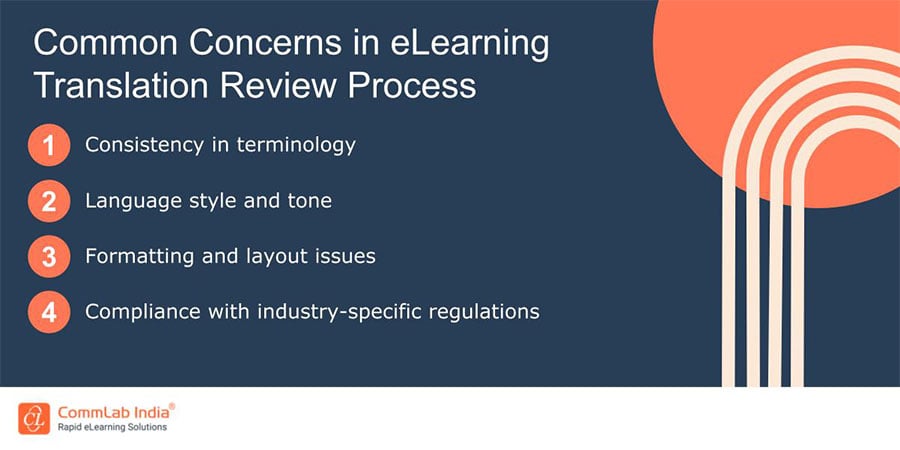Measuring the ROI of Rapid eLearning Translations: How to Evaluate Success

eLearning has become a popular mode of corporate training due to its convenience and cost-effectiveness. However, as eLearning courses continue to be created and translated into multiple languages, measuring the return on investment (ROI) for these translations becomes more important. How can you tell if your translated rapid eLearning course is successful, and how can you measure its ROI? In this blog post, we will explore some best practices to implement rapid eLearning translations and a few effective ways to evaluate their success.
Trying to Measure the Success of Your Rapid eLearning Translations?
Here are a few ways you can do it effectively –
- Define your objectives and success metrics
- Conduct Surveys
- Track Completion Rates
- Evaluate Learner Performance
- Analyze Costs
Read on to check out a bunch of best practices to implement rapid eLearning translations.
Best Practices for eLearning Translations: A Comprehensive Guide
1. Plan Ahead
Before you begin the eLearning translation process, it is important to plan ahead. Start by identifying your target audience and the languages that you need to translate your content into. This will help you determine the scope of your translation project and develop a timeline for completion. It is also important to consider any cultural differences that may affect the way your content is received by your target audience.
→ Download eBook Now: eLearning and ROI
2. Use Clear and Concise Language
When creating eLearning content, it is important to use clear and concise language. This is especially important when creating master course content for translation. Avoid using complex vocabulary, idiomatic expressions, or regional references that may be difficult to translate. Use simple sentences and avoid ambiguous language that may be misinterpreted in translation.
3. Try to be Culturally Appropriate
It is extremely crucial to follow the process of adapting content for a specific culture or language. This involves not only translating the text but also adapting the images, graphics, and other multimedia content to the target culture. Consider hiring a professional specialist who can help you create culturally appropriate content that resonates with your target audience.
4. Work with Professional Translators
Working with professional translators is essential for creating high-quality rapid eLearning translations. Professional translators have the linguistic and cultural expertise needed to accurately translate your content into different languages. They can also ensure that your content is consistent across different translations and that the tone and style of your content are maintained. Here are a few eLearning translation trends a professional translator needs to be aware of, to provide you with the best possible results.

5. Use Translation Memory Software
Translation memory software is a tool that can help streamline the translation process by storing previously translated content in a database. This can save time and improve consistency in translations. Translation memory software can also help reduce translation costs by identifying content that has already been translated and reusing it in new translations.
6. Use Quality Assurance Tools
Quality assurance tools are essential for ensuring that your rapid eLearning translations are accurate and error-free. These tools can help identify grammatical and spelling errors, inconsistencies, and other issues that may affect the quality of your translations. Consider using a professional proofreader or editor who can review your translations for accuracy and readability.

7. Conduct User Testing
User testing is an important part of the rapid eLearning translation process. This involves testing your translated content with actual users to ensure that it is effective and engaging. User testing can help you identify any issues with the translation, such as unclear instructions or cultural references that may not be familiar to your target audience.
Measuring the ROI of eLearning Translations: How to Evaluate Success
1. Define your Objectives and Success Metrics
Before you begin evaluating the ROI of your eLearning translations, you need to define your objectives. Your objectives may include reducing employee turnover, increasing productivity, or improving customer satisfaction. Once you have defined your objectives, you can develop metrics to track your progress. These metrics may include completion rates, learner satisfaction, improved employee performance, or other measurable outcomes. Once you have identified the key metrics, it becomes easier to evaluate the ROI of your eLearning translation. For example, if your objective is to reduce employee turnover, you may track the number of employees who complete the eLearning program and remain with the company.
2. Conduct Surveys
Surveys can be a valuable tool for measuring the success of eLearning translations. You can send out surveys to learners who have completed the translated course, asking for feedback on the content, the translation quality, and any other factors that may have impacted their experience. This feedback can then be used to identify areas of improvement and to fine-tune the translation process. While we are talking about improvement, here are a few pitfalls to avoid, to eventually improve the process and final output.
3. Track Completion Rates
Completion rates are another important metric for measuring the ROI of eLearning translations. By tracking completion rates for the translated course, you can determine whether learners are engaging with the material and whether the translation is effective. If completion rates are low, it may be an indication that the translation needs to be improved.
4. Evaluate Learner Performance
The ultimate goal of any eLearning course is to improve learner performance. By evaluating the performance of learners who have completed the translated course, you can determine whether the translation has been effective. For example, if the translated course is designed to teach employees a new skill, you can evaluate their performance before and after completing the course to determine whether the translation has been successful.
5. Analyze Costs
Finally, it’s important to analyze the costs associated with eLearning translations to determine their ROI. This may include the cost of translating the course, the cost of implementing the course, and any other related expenses. By comparing these costs to the benefits derived from the translated course, you can determine whether the ROI is positive.
Wrapping Up!
In conclusion, measuring the ROI of rapid eLearning translations is essential for evaluating their success. By defining success metrics, conducting surveys, tracking completion rates, evaluating learner performance, and analyzing costs, you can determine whether your translated eLearning course is effective and worth the investment. When we are already talking about ROI, you might be interested to know everything about ROI. Here’s an eBook that will explain to you all about ROI and help you ensure your training brings out the best results.




